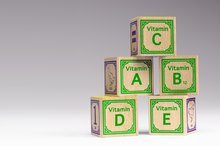What does fact checked mean?
At Healthfully, we strive to deliver objective content that is accurate and up-to-date. Our team periodically reviews articles in order to ensure content quality. The sources cited below consist of evidence from peer-reviewed journals, prominent medical organizations, academic associations, and government data.
The information contained on this site is for informational purposes only, and should not be used as a substitute for the advice of a professional health care provider. Please check with the appropriate physician regarding health questions and concerns. Although we strive to deliver accurate and up-to-date information, no guarantee to that effect is made.
Alternatives to Iron Fortified Rice Cereal
For many babies, iron-fortified rice cereal is the first introduction to solid foods. One big reason for this is that iron-fortified cereal helps reduce the chances of iron deficiency, since iron stores start to become depleted about the same time a baby begins to eat solid foods. However, there are plenty of other options to consider that can ease your baby's way into solids without risking an iron deficiency. Speak with your baby's pediatrician to determine the best foods for your child's needs.
Breast Milk and Formula
If your baby is formula fed and still gets 24 to 36 ounces of iron-fortified formula a day, he should not need any extra iron in his diet, so you can start him on any age-appropriate solid foods you like 12. Likewise, breast milk contains enough iron to sustain an exclusively breastfed baby, so if your child is still primarily breastfed, he may be getting sufficient iron from your milk. As you increase the level of solids and decrease the amount of breast milk or formula, you will have to add other iron-rich foods to your infant's diet.
- If your baby is formula fed and still gets 24 to 36 ounces of iron-fortified formula a day, he should not need any extra iron in his diet, so you can start him on any age-appropriate solid foods you like 1.
- As you increase the level of solids and decrease the amount of breast milk or formula, you will have to add other iron-rich foods to your infant's diet.
Meat and Eggs
Can 4-Month-Old Babies Eat Brown Rice?
Learn More
Some parents start a baby directly onto whole or pureed foods, skipping the baby cereal entirely. Meat and poultry are excellent sources of iron and can be pureed to suit a toothless baby’s feeding ability. Egg yolks are another good iron source, and they are easy to mash with a fork when hard boiled.
Vegetables and Fruits
Plenty of vegetables and fruits have iron and are suitable for babies. Mashed sweet potato is a high-iron vegetable that is frequently served as a first baby food. Broccoli, spinach, kale and asparagus also contain iron and can be cooked and pureed along with a small amount of rice. Dried fruits aren’t usually safe for a baby when served whole because they are a choking hazard, but you can puree stewed prunes or apricots with brown rice and a small amount of blackstrap molasses for a homemade baby food with plenty of iron 1. If your baby’s primary iron consumption comes from fruits and vegetables, make sure to also include foods high in vitamin C in her diet because vitamin C helps the body better absorb plant-based iron 12.
- Plenty of vegetables and fruits have iron and are suitable for babies.
- Broccoli, spinach, kale and asparagus also contain iron and can be cooked and pureed along with a small amount of rice.
Supplements
High-Fat, Non-Dairy Foods for Babies
Learn More
Iron supplements are another option for babies who can't get enough iron, but they are rarely necessary in full-term, healthy infants. Giving a child an iron supplement when he doesn't need one can increase iron levels to a dangerous level, so give iron supplements only if your baby's doctor has prescribed them.
Related Articles
References
- Wholesome Baby Food: Iron And Your Baby
- MedlinePlus: Iron in Diet
- U.S. Department of Health and Human Services. National Institutes of Health. Iron Fact Sheet for Health Professionals. Office of Dietary Supplements. Published 2019.
- Sun J, Zhang L, Cui J et al. Effect of dietary intervention treatment on children with iron deficiency anemia in China: a meta-analysis. Lipids Health Dis. 2018;17(1). doi:10.1186/s12944-018-0749-x
- Beck KL, Conlon CA, Kruger R, Coad J. Dietary determinants of and possible solutions to iron deficiency for young women living in industrialized countries: a review. Nutrients. 2014;6(9):3747-76. doi:10.3390/nu6093747
- Hurrell R, Egli I. Iron bioavailability and dietary reference values. Am J Clin Nutr. 2010;91(5):1461S-1467S. doi:10.3945/ajcn.2010.28674F
- Institute of Medicine. 2001. Dietary Reference Intakes for Vitamin A, Vitamin K, Arsenic, Boron, Chromium, Copper, Iodine, Iron, Manganese, Molybdenum, Nickel, Silicon, Vanadium, and Zinc. Washington, DC: The National Academies Press. doi:10.17226/10026
- Zijp IM, Korver O, Tijburg LB. Effect of tea and other dietary factors on iron absorption. Crit Rev Food Sci Nutr. 2000;40(5):371-98. doi:10.1080/10408690091189194
- Centers for Disease Control and Prevention. Iron.
- Makrides, M., Hawkes, J. S., Neumann, M. A., & Gibson, R. A. (2002). Nutritional effect of including egg yolk in the weaning diet of breast-fed and formula-fed infants: a randomized controlled trial. The American Journal of Clinical Nutrition, 75(6), 1084–1092. doi:10.1093/ajcn/75.6.1084
- Itske M. Zijp, Onno Korver & Lilian B. M. Tijburg (2000) Effect of Tea and Other Dietary Factors on Iron Absorption, Critical Reviews in Food Science and Nutrition,40:5, 371-398, doi:10.1080/10408690091189194
- Lönnerdal, B. (2010). Calcium and Iron Absorption - Mechanisms and Public Health Relevance. International Journal for Vitamin and Nutrition Research, 80(45), 293–299. doi:10.1024/0300-9831/a000036
- Geerligs PD, Brabin BJ, Omari AA. Food prepared in iron cooking pots as an intervention for reducing iron deficiency anaemia in developing countries: a systematic review. J Hum Nutr Diet. 2003;16(4):275-81. doi:10.1046/j.1365-277X.2003.00447.x
- Abhilash KP, Arul JJ, Bala D. Fatal overdose of iron tablets in adults. Indian J Crit Care Med. 2013;17(5):311-3. doi:10.4103/0972-5229.120326
- Hamilton JPA, By, Hamilton JPA. Secondary Iron Overload - Blood Disorders. Merck Manuals Consumer Version.
- Iron - Infant and Toddler Nutrition. Centers for Disease Control and Prevention. Published 2018.
- Milk Free Diet For Iron Deficiency Anemia. Children's Hospitals and Clinics of Minnesota.
- Abhilash KP, Arul JJ, Bala D. Fatal overdose of iron tablets in adults. Indian J Crit Care Med. 2013;17(5):311–313. doi:10.4103/0972-5229.120326
- Beck KL, Conlon CA, Kruger R, Coad J. Dietary determinants of and possible solutions to iron deficiency for young women living in industrialized countries: a review. Nutrients. 2014;6(9):3747–3776. Published 2014 Sep 19. doi:10.3390/nu6093747
- de Benoist B, McLean E, Egil I, Cogswell M, eds. Worldwide Prevalence of Anaemia 1993-2005. World Health Organization, Centers for Disease Control and Prevention.
- Geerligs P, Brabin B, Omari A. Food prepared in iron cooking pots as an intervention for reducing iron deficiency anaemia in developing countries: a systematic review. Journal of Human Nutrition and Dietetics. 2003;16(4):275-281. doi:10.1046/j.1365-277x.2003.00447.x
- Hamilton, JPA. Secondary Iron Overload - Blood Disorders. Merck Manuals Consumer Version. February 2019.
- Hurrell R, Egli I. Iron bioavailability and dietary reference values. The American Journal of Clinical Nutrition. 2010;91(5). doi:10.3945/ajcn.2010.28674F
- Johnson-Wimbley T, Graham D. Diagnosis and management of iron deficiency anemia in the 21st century. Therap Adv Gastroenterol. 2011;4(3):177-184. doi:10.1177/1756283x11398736
- Verster A. Food fortification: good to have or need to have? Eastern Mediterranean Health Journal. 2004;10(6).
Writer Bio
Bridget Coila specializes in health, nutrition, pregnancy, pet and parenting topics. Her articles have appeared in Oxygen, American Fitness and on various websites. Coila has a Bachelor of Science in cell and molecular biology from the University of Cincinnati and more than 10 years of medical research experience.









